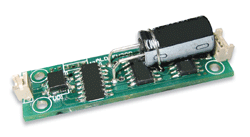The EH300 and EPAD energy-harvesting modules accept energy from an assortment of widely available ambient energy sources that operate from vibration, light, chemical reaction, fluid and air flow, environmental heat, and others. The modules then store this energy to power conventional electrical circuits and systems such as wireless sensor networks or remote controls. The modules are completely self-powered, always in the active mode, and always ready to harvest energy from sources that generate intermittent energy impulses with varying source impedances.

The technology behind this award-winning design came, as CEO Bob Chao says, incrementally since the inception of Advanced Linear Devices in 1985, when the company focused on building high-precision CMOS devices. Bob and several top designers made extremely precise op amps and voltage comparators and were successful at it, but their goal was to replace a very expensive laser-trimming system. They made a floating-gate technology on-chip to easily trim the circuits.
Every 2 to 3 years they created new ways that improved on the technology. It went through 8 to 10 iterations before they had a successful prototype. They did trimming at many different levels after the wafer was finished and then designed circuits and tested circuits before making components such as voltage comparators.
ALD’s aim was not to compete with mass production companies, but to make extremely precise circuits that no one else could make. Recently, ALD decided to offer the electrically programmable analog device (EPAD) MOSFET to design engineers. This programmable IC contains MOSFET transistors with programmable threshold voltages. Once programmed, the set voltage and current levels are stored indefinitely inside the device, even with power removed. They can get better then 10 mV and can get down to 10 µV.
ALD’s first customer had a piezoelectric design and wanted to make an energy-harvesting circuit, but needed the EPAD MOSFET to get it working. The customer had designed an unsuccessful circuit that captured less energy then what was consumed. Inside the energy harvesting are many circuits: voltage reference, two comparators, detection circuit, and a driver that consumes 30 to 40 nA. It’s not a fast circuit, but it doesn’t have to be; it needs to be efficient. The key to an energy-harvesting circuit has to be zero power used (or as close as possible) to harvest the energy. This device was a series of little and not so little breakthroughs over 23 years, fueled by perseverance and based on solid engineering.
Paul O’Shea
Advertisement
Learn more about Advanced Linear Devices





